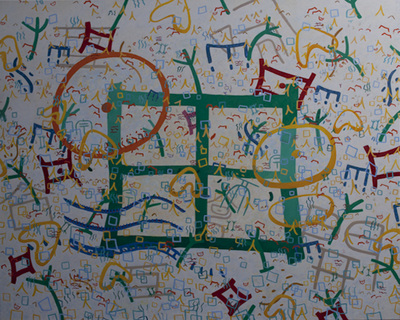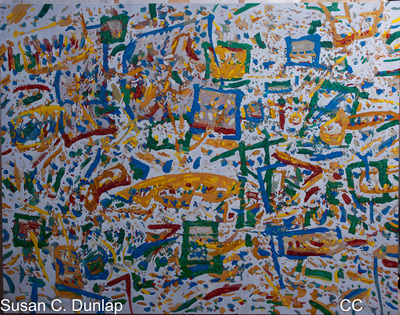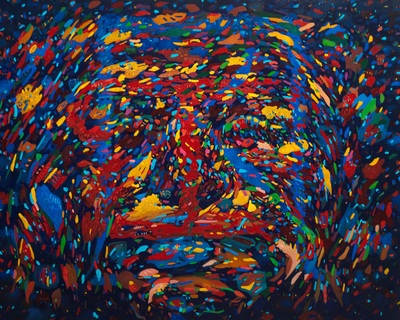Paintings in Oil: Abstracts with Contemporary & Ancient Chinese Characters. 2011-2014.
The style shown here emerged directly out of the earlier Abstract Series and is executed using old master techniques—numerous glaze layers built up to develop saturation and to depict form. I have been using this technique since the early 1990's. As with my watercolors, these pieces are luminous and convey crisply defined 'floating' shapes. The large pieces take on average six months to complete.
'Free At Last' 48” x 60” 2010-2014 终于自由 Dedicated to Cleo Condoravdi and Paul Kiparsky
Three of these paintings have a poem integrated into them.
In 2012, I learned about the origin of a tradition in China to include a motto or poem in a painting . Typically the words are presented in an isolated portion of the painting or as a scroll down one side or the other. I also learned that the 'empty space' found in many works of eastern art is a symbol of space that allows the movement of wind—it is space left for wind to move through the landscape or one's mind. I understood that the corollary for this in western culture is a respect for space and wilderness.
My goal was to fuse Chinese cultural distinctions with those found in western art. I was ambitions to give Chinese individuals a foothold into abstract art--using some of their own cultural attributes to do so. I devised two strategies to pursue this goal: 'scrambling' the words used in a poem by floating the characters all over the painting, and by working with ancient characters. By using ancient characters I could blend the aesthetic preferences of both cultures, and give individuals from each one an entry point into the work I used movement as one of the elements shared by both cultures.
In 2012, I learned about the origin of a tradition in China to include a motto or poem in a painting . Typically the words are presented in an isolated portion of the painting or as a scroll down one side or the other. I also learned that the 'empty space' found in many works of eastern art is a symbol of space that allows the movement of wind—it is space left for wind to move through the landscape or one's mind. I understood that the corollary for this in western culture is a respect for space and wilderness.
My goal was to fuse Chinese cultural distinctions with those found in western art. I was ambitions to give Chinese individuals a foothold into abstract art--using some of their own cultural attributes to do so. I devised two strategies to pursue this goal: 'scrambling' the words used in a poem by floating the characters all over the painting, and by working with ancient characters. By using ancient characters I could blend the aesthetic preferences of both cultures, and give individuals from each one an entry point into the work I used movement as one of the elements shared by both cultures.

In Praise of Yellow, 48” x 60” 2013. 酱黄
Poem:
Great, desirable, large sunrise
Praise the light of a bright sky
Gaze upon pure flight
Ancient Chinese characters are used throughout this painting.
The modern equivalent of those characters are:
海王, 良,祁,旦,奖, 明,亮,天,看,玉,飞
Poem:
Great, desirable, large sunrise
Praise the light of a bright sky
Gaze upon pure flight
Ancient Chinese characters are used throughout this painting.
The modern equivalent of those characters are:
海王, 良,祁,旦,奖, 明,亮,天,看,玉,飞







